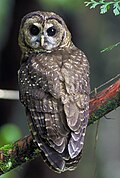Old-growth forest
An old-growth forest (also called primary forest, virgin forest, primeval forest, late seral forest, or in Britain, ancient woodland) is a forest that has reached a great age without much disturbance.
It has unique ecological features, and might be classified as a climax community.[1] Old-growth features include various tree-related structures. These provide wildlife habitats which increase the bio-diversity of the forested ecosystem.
Usually old-growth forests have multi-layered, open canopies.[2] The interwoven canopy often blocks sunlight from reaching lower trees or the forest floor. The old forests also include varied tree heights and diameters, with large fallen logs (or tree trunks) across the forest floor.[2] In Europe, less than 7% of forests are old-growth, as mainly due to industrial logging in the 20th century.[3] In the United States, estimates are that only 10% of old-growth forests remain.[4] In Asia old-growth forests are sometimes lost in regional conflicts.[5]
Old-growth Forest Media
Cool temperate rainforest in Tasmania, Australia
Antarctic beech old growth in Lamington National Park, Queensland, Australia
The northern spotted owl primarily inhabits old-growth forests in the northern part of its range (Canada to southern Oregon) and landscapes with a mix of old and younger forest types in the southern part of its range (the Klamath region and California).
Virgin forest about 2,500 m (8,200 ft) above sea level in Shennongjia Forestry District, Hubei, China
Downed wood replenishes topsoil as it decays
Fungus Climacocystis borealis on a tree stump in the Białowieża Forest, one of the last largely intact primeval forests in Central Europe
Redwood tree in northern California redwood forest: According to the National Park Service, "96 percent of the original old-growth coast redwoods have been logged."
Avatar Grove near Port Renfrew, British Columbia: Giant Douglas firs (left) and red cedars (right) fill the grove.
Eucalyptus regnans forest in Tasmania, Australia
References
- ↑ White, David; Lloyd, Thomas (1994). "Defining old growth: implications for management". Eighth Biennial Southern Silvicultural Research Conference. Archived from the original on 8 May 2016. Retrieved 23 November 2009.
- ↑ 2.0 2.1 Ramon Bravo Gonzalez, NGO influence on forest legislation: experiences from federal forest management in the United States (Lunds universitet/Internationella miljöinstitutet 2003), p. 7
- ↑ Marjatta Hytönen 2001. Social sustainability of forestry in northern Europe: research and education (Copenhagen: Nordic Council of Ministers, p. 206
- ↑ Forest Ecosystem Management Assessment Team (U.S.); United States. Forest Service, Forest ecosystem management: an ecological, economic, and social assessment (Washington, DC: US Forest Service, 1993), p. 79
- ↑ Takehisa Awaji & Shun'ichi Teranishi (eds.) 2005. The state of environment in Asia: 2005/2006, eds. (Tokyo: Springer-Verlag, p. 95.








